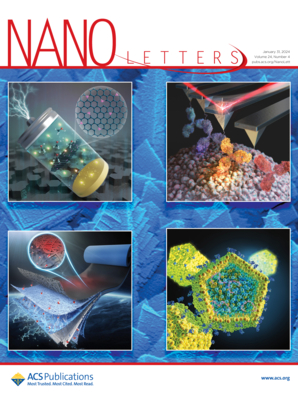Defectless and Uniform Single-Crystallite Dispersions of Sustainable Wood Nanocellulose with a Regulated Right-Handed Twist Periodicity
IF 9.1
1区 材料科学
Q1 CHEMISTRY, MULTIDISCIPLINARY
引用次数: 0
Abstract
Controlling the quality of cellulose nanofibers (CNFs), such as dispersibility and defects, is crucial for fully exploiting sustainable wood-derived CNFs. The dispersibility of CNFs is now tailorable, whereas the defects are still uncontrollable. This study is the first to demonstrate defect suppression through the selection of raw material species and the chemical pretreatment for cellulose. Two raw materials of softwood pulp and holocellulose are chosen from the perspective of the nanoscale supramolecular structure of plant celluloses. These two materials are subjected to regioselective surface oxidation using 4-acetamido-2,2,6,6-tetramethylpiperidinyl-1-oxyl as a catalyst at two different pHs to prepare four types of CNFs. Through statistical analysis of the CNF morphology using atomic force microscopy (AFM) image processing, we found a process yielding defectless CNF dispersions comprising uniform single crystallite units of cellulose. Wavelet transform analysis of AFM height profiles further revealed that the defectless CNFs exhibit regulated twist periodicity along much of their length.

具有调节右手扭周期性的可持续木材纳米纤维素的缺陷和均匀的单晶分散体
控制纤维素纳米纤维(CNFs)的质量,如分散性和缺陷,是充分利用可持续木材来源的CNFs的关键。目前CNFs的分散性是可调整的,但缺陷仍然是不可控的。本研究首次证明了纤维素通过原料种类的选择和化学预处理来抑制缺陷。从植物纤维素的纳米级超分子结构角度出发,选择了软木浆和全新纤维素两种原料。以4-乙酰胺-2,2,6,6-四甲基哌啶基-1-氧为催化剂,在两种不同的ph下对这两种材料进行了区域选择性表面氧化,制备了四种CNFs。通过使用原子力显微镜(AFM)图像处理对CNF形态进行统计分析,我们发现了一种由均匀的纤维素单晶单元组成的无缺陷CNF分散体的工艺。对AFM高度分布的小波变换分析进一步表明,无缺陷CNFs在其大部分长度上表现出可调节的扭转周期性。
本文章由计算机程序翻译,如有差异,请以英文原文为准。
求助全文
约1分钟内获得全文
求助全文
来源期刊

Nano Letters
工程技术-材料科学:综合
CiteScore
16.80
自引率
2.80%
发文量
1182
审稿时长
1.4 months
期刊介绍:
Nano Letters serves as a dynamic platform for promptly disseminating original results in fundamental, applied, and emerging research across all facets of nanoscience and nanotechnology. A pivotal criterion for inclusion within Nano Letters is the convergence of at least two different areas or disciplines, ensuring a rich interdisciplinary scope. The journal is dedicated to fostering exploration in diverse areas, including:
- Experimental and theoretical findings on physical, chemical, and biological phenomena at the nanoscale
- Synthesis, characterization, and processing of organic, inorganic, polymer, and hybrid nanomaterials through physical, chemical, and biological methodologies
- Modeling and simulation of synthetic, assembly, and interaction processes
- Realization of integrated nanostructures and nano-engineered devices exhibiting advanced performance
- Applications of nanoscale materials in living and environmental systems
Nano Letters is committed to advancing and showcasing groundbreaking research that intersects various domains, fostering innovation and collaboration in the ever-evolving field of nanoscience and nanotechnology.
 求助内容:
求助内容: 应助结果提醒方式:
应助结果提醒方式:


